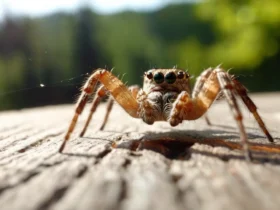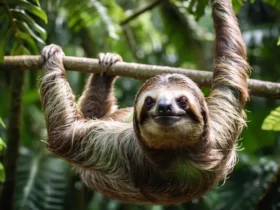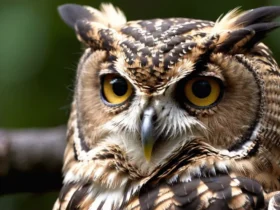Shhh, can you hear that? Probably not – and that’s exactly why some animals are so deadly. They move with stealth, silently stalking their prey before attacking. While big, loud predators can be intimidating, it’s often the ones you don’t hear coming that are the most lethal.
If you’re short on time, here’s a quick answer: Some of the most silent yet deadly animals include snakes like vipers and cobras that stealthily slither, big cats like leopards that quietly creep through vegetation, owls with specialized feathers to dampen noise while flying, poisonous fish and octopuses that ambush their prey, and tiny toxic spiders and scorpions.
Snakes That Slither in Silence
Vipers
Vipers are a type of venomous snake that are known for their ability to move with barely a sound. Their bodies have special adaptations that allow them to stealthily sneak up on prey. For example, vipers have no eyelids and their eyes are protected by a layer of transparent scales.
As a result, there is nothing to make a sound when they blink. Additionally, vipers have smooth scales and a belly that drags along the ground, enabling smooth and quiet motion.
Some of the most famous silent vipers include rattlesnakes, copperheads, and cottonmouths. The rattlesnake is aptly named for the rattle at the end of its tail, which it shakes to warn predators of its lethal bite.
However, when hunting, the rattlesnake moves in complete silence, allowing it to strike before prey is aware of its presence. The copperhead viper relies on camouflage, with brown and copper patterning that disguises it among forest debris. This sneaky viper delivers a fast, quiet, and potent bite.
Similarly, the cottonmouth blends into swamps and lakes, then bites with lightning speed when disturbed.
Cobras
Cobras are another type of highly venomous snake with several silent species. For example, the black mamba is known as one of the world’s deadliest and most aggressive snakes. Luckily, black mambas rely on bites versus constricting prey, enabling them to use speed versus strength during an attack.
As a result, black mambas have evolved silent stalking abilities and can reach slithering speeds up to 12 miles per hour.
Similarly, king cobras are the longest venomous snake in the world, growing over 18 feet long. They sneak up on prey in silence before lifting up to one-third their body off the ground, then striking with deadly precision.
Comparatively, the ringneck cobra or ringhals of Africa is named for its defensive display of forming a hood and rocking. However, when hunting rodents in the wild, the ringneck is almost entirely soundless.
Stealthy Big Cats on the Prowl
Leopards
Known for their spotted coats and incredible agility, leopards (Panthera pardus) are fierce hunters that rely on stealth and surprise to catch prey. These big cats inhabit forests, grasslands, and deserts across Africa and Asia.
Weighing up to 90 kg, leopards are strong enough to haul carcasses twice their weight high into trees. This protects their meals from other predators like lions and hyenas.
When hunting, leopards sneak through vegetation and hide behind rocks or in trees. They patiently stalk prey like impalas, often for hours, before pouncing from as far as 6 meters away. With a running start, leopards can leap over 9 meters horizontally.
Their spotted fur provides camouflage in dappled light. Retractable claws also help them grip surfaces while climbing. Once within striking distance, they bite the neck to suffocate prey.
Advanced night vision gives leopards an edge after dark. Their eyes shine 6 times brighter than human eyes at night, detecting prey movement from over 200 meters away. Silent stepping allows them to sneak up on oblivious targets.
In fact, David Attenborough called the leopard “the most successful predator that has ever lived on Earth.” Over millions of years, these stealthy hunters have thrived across Asia and Africa.
Jaguars
In the rainforests of Central and South America lurks the elusive jaguar (Panthera onca). As the region’s largest cat, it grows over 1.8 meters long and weighs up to 100 kg. Living in dense jungle terrain, the big cat relies on stealth when hunting prey like deer, peccaries, and capybaras.
Jaguars possess spotted coats for camouflage in dappled light. Their short legs and muscular build allow them to crawl through underbrush while stalking. Once prey is spotted, the jaguar will creep along the forest floor or swim silently across rivers to get within striking range, often as close as 1-2 meters.
It then pounces with explosive power, delivering a lethal bite to sever the spinal cord.
Another stealthy hunting tactic sees jaguars wait patiently beside trails or watering holes at night. With excellent night vision, they attack unsuspecting prey that wander by in the darkness. The cat’s spots actually help by breaking up its outline in low light conditions.
Researchers found that in complete darkness, jaguars are invisible to prey beyond 3-4 meters away. This makes surprise ambushes highly effective. Overall, the jaguar’s combination of camouflage, stealthy movement, and patience at night make it an apex predator perfectly adapted to hunt rainforest prey.
Owls with Ultra-Quiet Flight
Barn Owls
With their distinctive heart-shaped faces and captivating dark eyes, barn owls are one of the world’s most recognizable owl species. But what makes them truly extraordinary is their ability to fly almost completely silently, swooping down on unsuspecting prey with barely a sound.
How do they achieve such stealthy flight?
Barn owls have several special adaptations that enable their near-silent flight. Their wings and body are covered in incredibly soft feathers that absorb sound as air flows over them. The leading edges of their wings, in particular, are fringed with a velvety down that muffles noise.
Barn owls also have a fluffy fringe of feathers on the edges of their legs and feet that smooths airflow. This combination of sound-dampening feathers allows barn owls to fly more quietly than other owls.
In addition, barn owls have asymmetrically positioned ear openings on their heart-shaped faces. This allows them to accurately locate prey by sound alone, even in total darkness. They can hear noises as quiet as 1 decibel from over 100 feet away!
Using their hypersensitive hearing and specialized feathers, barn owls are able to silently swoop down and snatch up mice, voles and other small mammals with deadly accuracy.
Researchers have found that barn owls glide more than flap their wings during flight. Gliding minimizes noise from wingbeats, enabling their stealthy hunting. Barn owls are so adept at silent flight that their prey often doesn’t detect them until the last moment before attack.
This gives the owls an advantage when hunting at night.
So while they may look cute and cuddly, behind those heart-shaped faces lies an incredibly sophisticated and silent predator. The next time you see a barn owl, take a moment to appreciate the engineering marvel that is their quiet flight. 🦉
Great Horned Owls
With their impressive ear tufts, intimidating yellow-eyed stare, and deep hooting calls, great horned owls are a formidable presence in the night. But despite their large size and powerful talons, great horned owls can fly with remarkable silence, making them dangerously effective nocturnal hunters.
Great horned owls have several adaptations that enable their silent flight. Their broad wings are edged with a fringe of soft, comb-like feathers that dampen and muffle the sound of air flowing over them during flight.
The trailing edge of each wing feather is also fringed for maximum noise reduction.
In addition, great horned owls have a fluffy ring of feathers around their face, as well as leg and toe feathers, that smooth airflow and minimize turbulence. Their body is covered in incredibly soft, downy plumage that further absorbs sound.
Even their flight feathers lack the stiff central shafts of other birds, allowing them to fly more quietly.
Great horned owls also glide more than flap their wings when possible, reducing noise from wingbeats. And their wingtips flex to distribute aerodynamic forces, preventing loud noise from air rushing over the wings.
Thanks to these noise-reducing adaptations, great horned owls can approach their prey almost inaudibly.
Like other owls, great horned owls have asymmetrically placed ear openings that give them excellent directional hearing. They can detect faint squeaks and rustling noises made by mice, rabbits, and other prey.
Their silent flight, coupled with their acute hearing, makes great horned owls dangerously effective nocturnal hunters.
So the next time you hear a deep hooting at night, listen closely for the near-silent swoosh of wings overhead. With their stealthy flight and razor-sharp talons, great horned owls are truly masters of the night sky! 🦉
Poisonous Ambush Predators
Stonefish
The stonefish is likely the most venomous fish in the ocean and can deliver an extremely painful and potentially lethal sting if stepped on or touched. They typically bury themselves in sand or coral, perfectly camouflaging themselves and waiting patiently for prey to come within striking distance.
When threatened or stepped on, the stonefish injects its victim with neurotoxic venom from 13 spines along its dorsal fin. This venom can cause excruciating pain, paralysis, tissue death and even death if not treated promptly.
Stonefish stings cause an estimated 1,200 casualties in Australia’s coastal waters each year. Yikes! Steer clear of these camouflaged killers if you’re wading or swimming in their habitat.
Blue-Ringed Octopus
Though only the size of a golf ball, the blue-ringed octopus packs enough venom to kill 26 adults within minutes. They possess highly complex eyes, a beak for drilling into and eating prey such as crabs and shrimp, and their namesake blue rings that flash brightly when threatened.
The blue-ringed octopus is found in tide pools and coral reefs across the Pacific and Indian Oceans, from Japan to Australia. Their powerful neurotoxin called tetrodotoxin causes paralysis, respiratory arrest and ultimately death in many cases.
But no worries, while startlingly toxic, the blue-ring is a very docile creature that only bites when handled or stepped on accidentally. So give these psychedelically patterned mollusks a wide berth and simply admire their alien beauty from a distance if you’re lucky enough to spot one!
Tiny Toxic Terrors
Black Widow Spider
The black widow spider may be tiny, but it packs a powerful poisonous bite. Despite its small size, about 1.5 inches in body length, the female black widow has venom over 10 times more toxic than a rattlesnake’s. This venom affects the nervous system, causing severe muscle cramps, fever, and nausea.
While an adult death is rare, small children are at greater risk if bitten. Found throughout North America, these shiny black spiders with a red hourglass shape on the abdomen favor dark, undisturbed spaces like woodpiles, sheds, or outhouses.
If you see the messy web or spiky egg sacs of a black widow, steer clear and call pest control!
Here are some fascinating black widow spider facts:
- The female black widow’s powerful venom helps her immobilize prey, which includes insects, other spiders, and occasionally small vertebrates like lizards or mice.
- Only the adult female black widow is capable of envenomating humans in a defensive bite. The tiny male is harmless.
- The name “widow” refers to the old myth that the female eats the male after mating. While they do occasionally eat the male, this is rare.
- There are several species of widow spiders around the world, but the most notorious is the western black widow Latrodectus hesperus in North America.
- Population growth in suburbs and cities has increased black widow encounters with humans and bites. Protect kids and pets from getting too close!
While the black widow deservedly has a scary reputation, this creepy crawler plays an important role controlling insect populations. Proper precautions like gloves, closed-toe shoes, and pest control can prevent nasty encounters!
Deathstalker Scorpion
Don’t let the cute name fool you – the deathstalker scorpion is one of the most dangerous scorpions on Earth! This lethal arachnid inhabits desert regions of North Africa and the Middle East. Measuring around 3 inches long, the deathstalker scorpion may appear unassuming.
However, it possesses an extremely powerful venom that can cause severe pain, neurological issues, and even death in rare cases.
Here are some eye-opening facts about this tiny terror:
- The deathstalker scorpion’s scientific name Leiurus quinquestriatus refers to its distinctive yellowish tail with five longitudinal ridges.
- Its venom contains various toxins that affect sodium channels in the human body, causing pain, convulsions, shortness of breath, and other dangerous symptoms.
- Children, the elderly, and immunocompromised individuals are most vulnerable to the venom’s effects.
- Antivenom exists but may not be readily available depending on the region. Supportive medical care is crucial.
- Deathstalker stings kill between 1-2% of adult victims and up to 5% of children. Fatalities are rare with proper treatment.
While most scorpion species are relatively harmless, the deathstalker is extremely toxic. Stay vigilant when exploring desert regions where this tiny terror roams, and wear protective footwear. If stung, immediately seek medical attention.
With caution and awareness, we can admire this exotic arachnid from a safe distance!
Conclusion
While big noisy predators can seem scary, sometimes it’s the silent stalkers you need to watch out for. Animals like stealthy snakes, sneaky big cats, soundless owls, poisonous ambush predators, and tiny toxic creepy-crawlies may not be loud, but they can certainly be lethal.
Next time you’re out in nature, watch your step and keep an ear out for the quiet ones!








